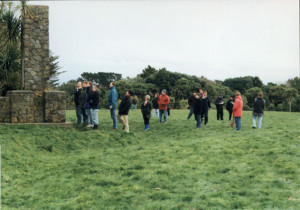 This area, South Taranaki especially, remained on an uneasy war-footing after 1860 after members of Ngāti Ruanui travelled north to support Te Ātiawa during the Waitara war.
This area, South Taranaki especially, remained on an uneasy war-footing after 1860 after members of Ngāti Ruanui travelled north to support Te Ātiawa during the Waitara war.
Ngāti Ruanui had returned south after the war and, unhappy at what had happened at Waitara, had later attacked Tataraimaka in 1863. In response, the British Army was sent into the area in ‘repress the Maori’ which it did with some ruthlessness, especially under the later command of Major General Trevor Chute.
Increasingly, however, the New Zealand Armed Constabulary was taking over the war, with the British Army returning home to England.
War was also made more complex by the rise of Hau hau in 1864.
Major wars were fought between Maori as Hau Hau spread, beyond Taranaki. A short period of peace was sharply broken by Titokowaru’s war 1868-69.
#
6 April 1864 British Army platoon attacked at Te Ahu Ahu, near Oakura, New Plymouth. Seven soldiers died, with twelve injured.
30 April 1864 Attack on Sentry Hill Redoubt, near Waitara, by Hau Hau Māori. Māori death toll very high with 50 killed and about 60 injured.
14 May 1864 War Party of Hau Hau Māori from mainly Taranaki attack Moutoa Island, then being defending by Whanganui Māori who win the day.
24-25 January 1865 British Army engages Māori at Nukumaru, near Patea.
21 July 1865 Commander of British Army, Lieut-General Cameron, decides not to attack fortress at Weraroa, instead marching past.
14 January -1 February 1866 skirmishing continues in Taranaki at Otapawa, Ketemarae, Mawhitiwhiti, Ahipaipa and Waikoko.
2 August – 2 October 1866 Fighting at Pokaikai, Ketemarae, Hawera, Waihi and Pungarehu.
Titokowaru’s War
12 July 1868 Titokowaru’s people attack Turuturu Mokai Redoubt in early morning raid. Though Armed Constabulary death toll is high – ten – the attack is repulsed.
21 August 1868 Unsuccessful attack on Te Ngutu O Te Manu by Armed Constabulary.
7 September 1868 Armed Constabulary attacks Te Ngutu O Te Manu again with disastrous results – twenty four constables are killed with twenty seven wounded. Toll for Māori however is also high – twenty eight men die.
One of the dead was German soldier Major Gustavus Von Tempsky, a notable if controversial frontier personality.
To read Danny’s article on Von Tempsky, as published in the Listener, 19 April 2003, pp. 30-31, see Major Von Tempsky.
7 November 1868 Unsuccessful Armed Constabulary attack on Moturoa, near Waverley.
2 February 1869 On the eve of an Armed Constabulary attack on Tauranga Ika, Māori vacate the Pā and retreat into the surrounding bush, bringing war on the West Coast to an end.
To see a map of the Central/South Taranaki conflicts, alongside the other fields of engagement that together comprised the New Zealand Wars, see Map of Conflicts.



